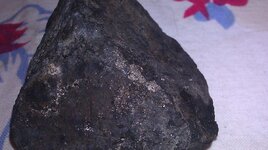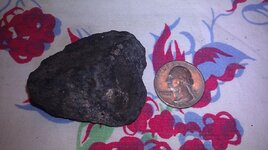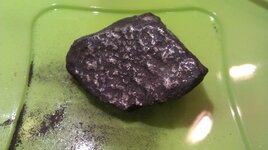Navigation
Install the app
How to install the app on iOS
Follow along with the video below to see how to install our site as a web app on your home screen.
Note: This feature may not be available in some browsers.
More options
You are using an out of date browser. It may not display this or other websites correctly.
You should upgrade or use an alternative browser.
You should upgrade or use an alternative browser.
Need Help To Identify Todays Find
What you need to find is the density of the metal in there, because once you know that, you can look it up. The problem, however, is that your metal has a bunch of rock around it that is going to mess up your equation. So you have to do some math to figure out what you're looking at.
BUT apparently you need the specific gravity... So you might want to do some more research on how to find the specific gravity of something, and then find the difference between your rock and a regular rock. The following paragraphs are just an idea of how you might get started. Good luck!
Find a rock about the same size from the same location, the same type, weigh it. That's the MASS.
Then put it in a measurable glass, and add water to a certain level above it. Take out the rock and measure the water again. The difference between levels is the VOLUME.
Calculate the density of the rock by dividing mass/volume=density.
Then do the same with the metal-containing rock.
Each of these will give you the density of whatever you are looking at. (But not the specific gravity...)
Ok, from here on it's just speculation...
Then find the difference in size between the rocks. Your next equation will be the Non-metallic rock's volume plus or minus the difference / mass= density. This is the density of the nonmetal rock if it were the same size as your metal one?
Finally, take that resulting number and find the difference between the rocks. Maybe. I am totally unsure. Sorry I couldn't be of more help!
BUT apparently you need the specific gravity... So you might want to do some more research on how to find the specific gravity of something, and then find the difference between your rock and a regular rock. The following paragraphs are just an idea of how you might get started. Good luck!
Find a rock about the same size from the same location, the same type, weigh it. That's the MASS.
Then put it in a measurable glass, and add water to a certain level above it. Take out the rock and measure the water again. The difference between levels is the VOLUME.
Calculate the density of the rock by dividing mass/volume=density.
Then do the same with the metal-containing rock.
Each of these will give you the density of whatever you are looking at. (But not the specific gravity...)
Ok, from here on it's just speculation...
Then find the difference in size between the rocks. Your next equation will be the Non-metallic rock's volume plus or minus the difference / mass= density. This is the density of the nonmetal rock if it were the same size as your metal one?
Finally, take that resulting number and find the difference between the rocks. Maybe. I am totally unsure. Sorry I couldn't be of more help!
Lanny in AB
Gold Member
- Apr 2, 2003
- 5,670
- 6,413
- Detector(s) used
- Various Minelabs(5000, 2100, X-Terra 705, Equinox 800, Gold Monster), Falcon MD20, Tesoro Sand Shark, Gold Bug Pro, Makro Gold Racer.
- Primary Interest:
- Prospecting
While you're at it, look up how to do a streak test--that may be a great way to determine what you've got as metals leave a specific color of streak.
What's the hardness/softness of the metal? (Can you carve it [peel slivers/shavings of it from the host body] with a knife blade?) Check out that as well.
Being non-magnetic (Did you use a supermagnet to test it? Is it even slightly magnetic?) certainly rules out a bunch of other possibilities--like an iron meteorite with a black fusion crust from a recent atmospheric entry.
Also, were you detecting around where there might have been an old smelter?
All the best,
Lanny
What's the hardness/softness of the metal? (Can you carve it [peel slivers/shavings of it from the host body] with a knife blade?) Check out that as well.
Being non-magnetic (Did you use a supermagnet to test it? Is it even slightly magnetic?) certainly rules out a bunch of other possibilities--like an iron meteorite with a black fusion crust from a recent atmospheric entry.
Also, were you detecting around where there might have been an old smelter?
All the best,
Lanny
Last edited:
Lanny in AB
Gold Member
- Apr 2, 2003
- 5,670
- 6,413
- Detector(s) used
- Various Minelabs(5000, 2100, X-Terra 705, Equinox 800, Gold Monster), Falcon MD20, Tesoro Sand Shark, Gold Bug Pro, Makro Gold Racer.
- Primary Interest:
- Prospecting
Slag or smelter spill (especially if it's non-magnetic) doesn't necessarily mean it's a bad thing (don't give up on your streak test just yet either or your harness test). That's why I asked if you'd been detecting in an area where there might have been an old smelter or processing area--even a primitive one. Sometimes there's been spectacular finds of quite high grade silver found this way, especially if there was an old, primitive Spanish smelter in the vicinity (or any other type of rudimentary miner's processing area), as after this much time has passed, there may be no easily visible signs of the smelter's existence.
Hope it works out for you.
All the best,
Lanny
Hope it works out for you.
All the best,
Lanny
[email protected]
Newbie
- Aug 21, 2015
- 1
- 0
- Primary Interest:
- All Treasure Hunting
Hi MrLee do you still have this rock? You may want to calculate the specific Gravity as I have found identical ones that come out to 19-21. Way too heavy for slag material. I am still trying to find an easy way to have them tested but they are not pyrite as some might tell you. Heated one up to 2000 degrees and it didn't change color at all. If you chip a fragment off you will find it is as shiny a silver white as you can get. It oxidizes super fast which makes my wonder if it has a rare earth element in there. Anyway there's more than one. If you want a picture of mine just email me.
Slag or smelter spill (especially if it's non-magnetic) doesn't necessarily mean it's a bad thing (don't give up on your streak test just yet either or your harness test). That's why I asked if you'd been detecting in an area where there might have been an old smelter or processing area--even a primitive one. Sometimes there's been spectacular finds of quite high grade silver found this way, especially if there was an old, primitive Spanish smelter in the vicinity (or any other type of rudimentary miner's processing area), as after this much time has passed, there may be no easily visible signs of the smelter's existence.
Hope it works out for you.
All the best,
Lanny
I know a place where there's two old arrastras with the old dragging stones still down inside them.
Unfortunately the place was used by later miners as a dump for their cans for many years and detecting the area would be a nightmare.
Might try to remove the bottom rocks that line the arrastras and see if there's anything good down below there.
arizau
Silver Member
- May 2, 2014
- 2,518
- 3,947
- Detector(s) used
- Beach High Banker, Sweep Jig, Whippet Dry Washer, Lobo ST, 1/2 width 2 tray Gold Cube, numerous pans, rocker box, and home made fluid bed and stream sluices.
- Primary Interest:
- Prospecting
I know a place where there's two old arrastras with the old dragging stones still down inside them.
Unfortunately the place was used by later miners as a dump for their cans for many years and detecting the area would be a nightmare.
Might try to remove the bottom rocks that line the arrastras and see if there's anything good down below there.
I would not deconstruct the arrastras but I might at least try to clean out the cracks between the stones with crevicing tools. Depending on whose land those are located they may be protected by the Antiquities Act. https://www.google.com/webhp?source...US513&ion=1&espv=2&ie=UTF-8#q=antiquities act
Good luck.
I would not deconstruct the arrastras but I might at least try to clean out the cracks between the stones with crevicing tools. Depending on whose land those are located they may be protected by the Antiquities Act. https://www.google.com/webhp?source...US513&ion=1&espv=2&ie=UTF-8#q=antiquities act
Good luck.
I hear ya. I don't wanna go around destroying historical things. Checking the cracks might be good.
goldenIrishman
Silver Member
- Feb 28, 2013
- 3,465
- 6,153
- Detector(s) used
- Fisher / Gold Bug AND the MK-VII eyeballs
- Primary Interest:
- Other
Hit the cracks with one of AzVipers ViperVac units. Those vacs will suck a golf ball through a garden hose!
Top Member Reactions
-
 3344
3344 -
 1915
1915 -
 1877
1877 -
 1180
1180 -
 1088
1088 -
 857
857 -
 825
825 -
 817
817 -
 800
800 -
 788
788 -
 781
781 -
 530
530 -
 505
505 -
 477
477 -
 426
426 -
 419
419 -
E
414
-
 399
399 -
 397
397 -
 383
383
Users who are viewing this thread
Total: 2 (members: 0, guests: 2)










